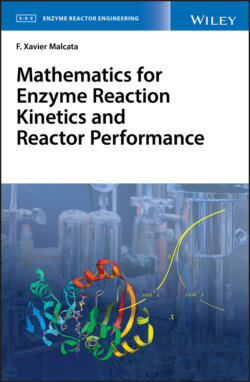Читать книгу Mathematics for Enzyme Reaction Kinetics and Reactor Performance - F. Xavier Malcata - Страница 54
5 Tensor Operations
ОглавлениеA tensor, τ, consists on the extrapolation of a vector to a three‐dimensional space, based on each of its three directional components – so it has no geometrical representation, being defined solely by its components in a Cartesian R9 domain; its notation resorts normally to matrix form, viz.
(5.1)
– so it can be formed by juxtaposition of three vectors of the type labeled as Eq. (3.6), or else
(5.2)
using Eq. (3.1) as template. The unit tensors, φi,j (i = x,y,z; j = x,y,z), are, in turn, defined as arrays of nine components (all of which are zero but one, equal to unity), according to
(5.3)
(5.4)
(5.5)
(5.6)
(5.7)
(5.8)
(5.9)
(5.10)
and
(5.11)
respectively – so Eqs. (3.3)–(3.5) are particular cases of Eqs. (5.3), (5.7), and (5.11).
In view of the (3 × 3) matrix representation of a tensor, one may retrieve all operations presented before to some length – as they are applicable also to tensors; this includes addition of matrices as per Eq. (4.4), multiplication of scalar by matrix as per Eq. (4.20), and multiplication of matrices as per Eq. (4.47). A number of operations specifically dealing with, or leading to tensors are, in addition, worth mentioning on their own – all of the multiplicative type, in view of the underlying portfolio of applications thereof.
One such multiplicative operation is the dyadic product of two vectors, u and v – also known as matrix product of the said vectors, since the first vector is multiplied by the transpose of the second via the algorithm labeled as Eq. (4.47); it is accordingly represented by
(5.12)
as opposed to Eq. (3.52) – and readily degenerates to
(5.13)
which abides to the definition of tensor conveyed by Eq. (5.1). The said representation is equivalent to
(5.14)
where the j ’s denote the unit vectors oriented along one of the Cartesian axes, previously labeled as Eqs. (3.3)–(3.5); comparative inspection of Eqs. (5.1) and (5.13) and of Eqs. (5.2) and (5.14) indicates that the double products of j 's can be seen as matrix products of the corresponding unit vectors, according to
(5.15)
(5.16)
(5.17)
(5.18)
(5.19)
(5.20)
(5.21)
(5.22)
and
(5.23)
In view of Eqs. (5.15)–(5.23), one may rewrite Eq. (5.14) as
(5.24)
– or, in a more condensed fashion,
(5.25)
provided that i and j denote x (i = 1 or j = 1), y (i = 2 or j = 2), or z (i = 3 or j = 3).
One may now briefly refer to the multiplication of scalar α by tensor τ – represented by
(5.26)
which may be rewritten as
(5.27)
in view of Eq. (5.2); the distributive and commutative properties of multiplication of scalar by matrix as per Eq. (4.34) produces
(5.28)
or, in condensed form,
(5.29)
– which is equivalent to writing
(5.30)
in parallel to Eq. (4.20).
The scalar (or dot) product of a vector u by a tensor τ is a vector defined by
(5.31)
inspired by Eq. (3.52) and taking advantage of Eq. (4.47) – or, in condensed form,
(5.32)
if the order of multiplication is reversed, one obtains
(5.33)
that may be rephrased as
(5.34)
– so inspection of Eq. (5.34) vis‐à‐vis with Eq. (5.32) indicates that
(5.35)
except if τ is symmetric (as τji = τij under such circumstances).
The scalar product of two tensors, σ and τ (also known as double dot product, :), is a scalar defined as
(5.36)
where straightforward algebraic rearrangement was used to advantage – or, in condensed form,
(5.37)
Here tensor σ abides to
(5.38)
while (1 × 3) row vectors σ_x, σ_y, and σ_z are defined as
(5.39)
(5.40)
and
(5.41)
respectively, whereas (3 × 1) column vectors τx_, τy_, and τz_ abide to
(5.42)
(5.43)
and
(5.44)
respectively.
Finally, the dot product of two tensors, σ and τ, may be considered, according to
(5.45)
thus generating another tensor; Eq. (5.45) is equivalent to writing
(5.46)
which mimics the classical product of two matrices – see Eq. (4.47).
